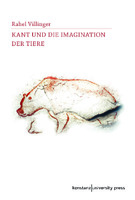Kant und die Imagination der Tiere
| dc.contributor.author | Villinger, Rahel | |
| dc.date.accessioned | 2019-01-07 23:55 | |
| dc.date.accessioned | 2018-12-01 23:55:55 | |
| dc.date.accessioned | 2019-02-04 11:17:01 | |
| dc.date.accessioned | 2020-04-01T11:51:18Z | |
| dc.date.available | 2020-04-01T11:51:18Z | |
| dc.date.issued | 2018 | |
| dc.identifier | 1002622 | |
| dc.identifier | OCN: 1082947172 | en_US |
| dc.identifier.uri | http://library.oapen.org/handle/20.500.12657/27388 | |
| dc.description.abstract | Kant's reflections on animals open up a hitherto overlooked approach to his conception of human intuition and imagination. In her book, Rahel Villinger shows how Kant's aesthetics, epistemology, and theory of history must be reread against the background of the assumption of sensible cognition in non-rational animals. Kant as a frigid thinker of human reason, who sees in the forces of sensibility nothing but immorality and animal baseness: this prejudice is still widespread. However, sensibility for Kant is first and foremost an autonomous and independent faculty of cognition through intuition and imagination. In this way, Kant’s account of sensibility differs radically from that of the rationalist school philosophy of his day and also from the newly emerging philosophy of German idealism. Furthermore, Kant thought that we need the imagination of other animals to be able to critically think our own. Therefore, an imagination of animals with Kant includes both: the notion of a superhuman power of purely sensible intuition and imagination whose singularity and immediacy reflect the perfection and infinity of divine intuition; and the specific imagination of rational animals, whose descriptive activity combines image and writing, intuition and concept, and which becomes possible only through the imagination of their prehistorical origin - their animal prototype. Kant’s reflections on animals thus reveal a hidden ambiguity in his thinking of sensible nature, which lives on in the foundations of modern aesthetics, poetics, and image theory. | |
| dc.language | German | |
| dc.subject.classification | thema EDItEUR::Q Philosophy and Religion::QD Philosophy | en_US |
| dc.subject.other | animals | |
| dc.subject.other | intuition | |
| dc.subject.other | imagination | |
| dc.subject.other | Kant | |
| dc.subject.other | aesthetics | |
| dc.subject.other | epistemology | |
| dc.subject.other | History of Philosophy | |
| dc.title | Kant und die Imagination der Tiere | |
| dc.type | book | |
| oapen.abstract.otherlanguage | Kants Reflexionen über die Tiere eröffnen einen bisher übersehenen Zugang zu seiner Konzeption menschlicher Anschauung und Einbildungskraft. In ihrem Buch zeigt Rahel Villinger, wie Kants Ästhetik, Erkenntnis- und Geschichtstheorie vor dem Hintergrund der Annahme eines tierischen Erkenntnisvermögens durch Anschauung und Einbildungskraft völlig neu lesbar werden. Kant als frigider Denker der menschlichen Vernunft, der in den Kräften der Sinnlichkeit nichts als Unmoralität und tierische Niedrigkeit sieht: Dieses Vorurteil ist immer noch weit verbreitet. Tatsächlich aber ist Sinnlichkeit für Kant ein eigenförmiges und eigenständiges Vermögen der Erkenntnis durch Anschauung und Einbildungskraft. Gegen die rationalistische Schulphilosophie seiner Zeit und auch gegen die neu aufkommende Philosophie des deutschen Idealismus hat Kant damit eine von der Vernunft unabhängige Sinnlichkeit radikal aufgewertet. Wir brauchen die Imagination anderer Tiere, um unsere eigene denken zu können und ihr kritisch die Grenzen zu ziehen. Darum umfasst eine Imagination der Tiere mit Kant beides: die Vorstellung einer übermenschlichen Kraft rein sinnlicher Anschauung und Einbildung, deren Singularität und Unmittelbarkeit die Vollkommenheit und Unendlichkeit göttlicher Anschauung spiegelt; und die spezifische Einbildungskraft vernünftiger Tiere, deren beschreibende Tätigkeit Bild und Schrift, Anschaulichkeit und Begriff verbindet, und die erst durch die Imagination ihres vorzeitigen Ursprungs - ihrer tierischen Urform - möglich wird. Am Leitfaden seiner Reflexionen über die Tiere wird so eine versteckte Doppelsinnigkeit in Kants Denken der sinnlichen Natur sichtbar, die die Grundlagen moderner Ästhetik, Poetik und Bildtheorie bestimmt. | |
| oapen.identifier.doi | 10.18148/KOPS/352-2-1M3CZBPI9A5B70 | |
| oapen.relation.isPublishedBy | 970be65d-42cb-430f-9ede-4f179a6dab98 | |
| oapen.relation.isFundedBy | 07f61e34-5b96-49f0-9860-c87dd8228f26 | |
| oapen.collection | Swiss National Science Foundation (SNF) | |
| oapen.pages | 232 | |
| oapen.grant.number | 10BP12_185527 | |
| oapen.identifier.ocn | 1082947172 |

